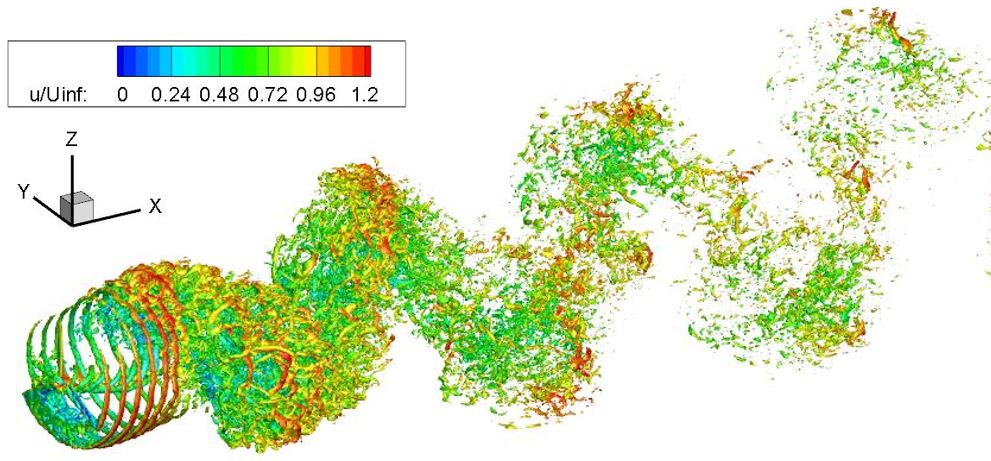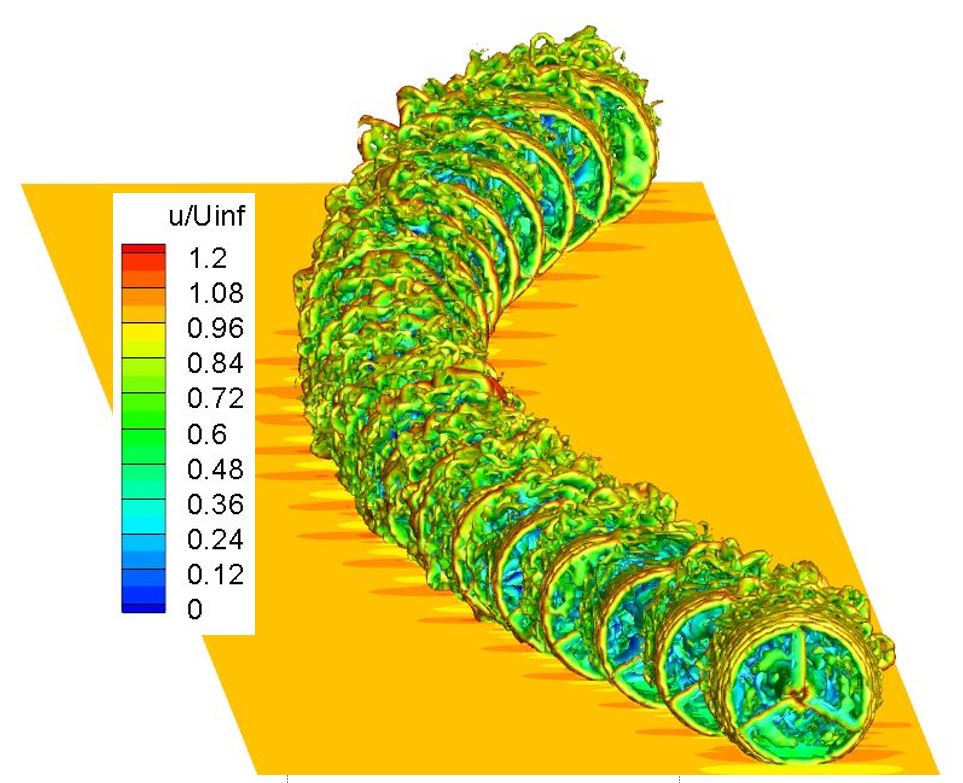CFD simulations of a wind turbine wake for rapid recovery of velocity deficits
JAXA Supercomputer System Annual Report April 2018-March 2019
Report Number: R18ETET09
Subject Category: Skills Acquisition System
- Responsible Representative: Yasutada Tanabe, Leader, High Speed Rotorcraft Research Section Aviation Systems Research Unit Aeronautical Technology Directorate
- Contact Information: The University of Tokyo, Keita Kimura(k.kimura@ilab.eco.rcast.u-tokyo.ac.jp)
- Members: Keita Kimura, Yasutada Tanabe
Abstract
In a large wind farm (arrays of wind turbines), wind turbine wake can cause power deficits or/and additional fatigue in turbine stands in wake region. In this study, several wake simulations were performed to obtain the characteristics of wind profiles in wind turbine wakes. These information can be used for design of wind farm.
In this year, we focused on the effect of rotational speeds and yaw angles on recovery processes of velocity deficits. In addition, simulations of multiple rotor are performed to investigate wake interferences in actual wind farms.
Reference URL
N/A
Reasons for using JSS2
In wind turbine wake simulations, comtutational domain should cover about 10 rotor diameters downwind because of its large impact range. On the other hand, to resolve the fluctuations from rotational blades, grid scales need to be the order of chord length of blade tips. As a result, it is necessary to put large computational grid which has high grid resolution. Thanks to JSS2, such simulations of high computational cost can be performed.
Achievements of the Year
Our numerical study focuses on the effects of tip speed ratio (TSR) and yaw angle on the recovery of velocity deficits. All simulations are performed by using rFlow3D. Fig.1 shows vorticity contours in the near-wake region. When increasing TSR, distances between vortices becomes narrows and vortex pairing occurs more easily. Consequently, it accelerates momentum exchanges between wake region and outer flow.
Fig.2 depicts a wake strucutures in active yawed condition, in which yaw angles change periodically. Dynamic meandering caused by an active yaw condition can be confirmed in the picture and it has strong mixing effects of wake as shown in Fig.3. Deficits of averaged wind speed in wake region quickly recover when the wake meanders dynamically.
Fig.4 shows isosurfaces of vorticity in a case of multiple rotors assuming large wind power plants. A problem of much computational time was solved by applying MPI techniques to multiple rotors. This simulations can evaluate rotor torques and velocity fields in various conditions of wake interferences at the same time.
Publications
– Peer-reviewed papers
1) Keita Kimura, Yasutada Tanabe, Yuichi Matsuo, and Makoto Iida. “Forced wake meandering for rapid recovery of velocity deficits in a wind turbine wake”, AIAA Scitech 2019 Forum, AIAA SciTech Forum, (AIAA 2019-2083)
– Oral Presentations
1) K. Kimura, Y. Tanabe, T. Aoyama, Y. Matsuo and M. Iida, “A NUMERICAL STUDY OF THE RELATION BETWEEN WAKE STRUCTURE AND WIND FLUCTUATION,” GRE 2018, Yokohama, Japan, June, 2018.
2) K. Kimura, Y. Tanabe, T. Aoyama, Y. Matsuo and M. Iida, “The relationship between vortex pairings and velocity deficit recovery in a wind turbine wake,” iTi conference 2018, Bertinoro, Italy, September, 2018.
3) K. Kimura, Y, Tanabe, Y, Matsuo and M. Iida. “A numerical study of the wake interference and wind distributions for offshore WPP,” 40th Wind Energy Symposium, Tokyo, December, 2018.
4) K. Kimura, Y. Tanabe, Y. Matsuo and M. Iida, “Forced wake meandering for rapid recovery of velocity deficits in a wind turbine wake,” 2019 Wind Energy Symposium, AIAA Scitech Forum, California, USA, January, 2019
Usage of JSS2
Computational Information
- Process Parallelization Methods: MPI
- Thread Parallelization Methods: OpenMP
- Number of Processes: 2 – 8
- Elapsed Time per Case: 300 Hour(s)
Resources Used
Fraction of Usage in Total Resources*1(%): 0.68
Details
Please refer to System Configuration of JSS2 for the system configuration and major specifications of JSS2.
| System Name | Amount of Core Time(core x hours) | Fraction of Usage*2(%) |
|---|---|---|
| SORA-MA | 9,046.58 | 0.00 |
| SORA-PP | 1,142,860.12 | 9.13 |
| SORA-LM | 0.00 | 0.00 |
| SORA-TPP | 0.00 | 0.00 |
| File System Name | Storage Assigned(GiB) | Fraction of Usage*2(%) |
|---|---|---|
| /home | 96.43 | 0.10 |
| /data | 10,850.70 | 0.19 |
| /ltmp | 2,170.14 | 0.19 |
| Archiver Name | Storage Used(TiB) | Fraction of Usage*2(%) |
|---|---|---|
| J-SPACE | 0.00 | 0.00 |
*1: Fraction of Usage in Total Resources: Weighted average of three resource types (Computing, File System, and Archiver).
*2: Fraction of Usage:Percentage of usage relative to each resource used in one year.
JAXA Supercomputer System Annual Report April 2018-March 2019






